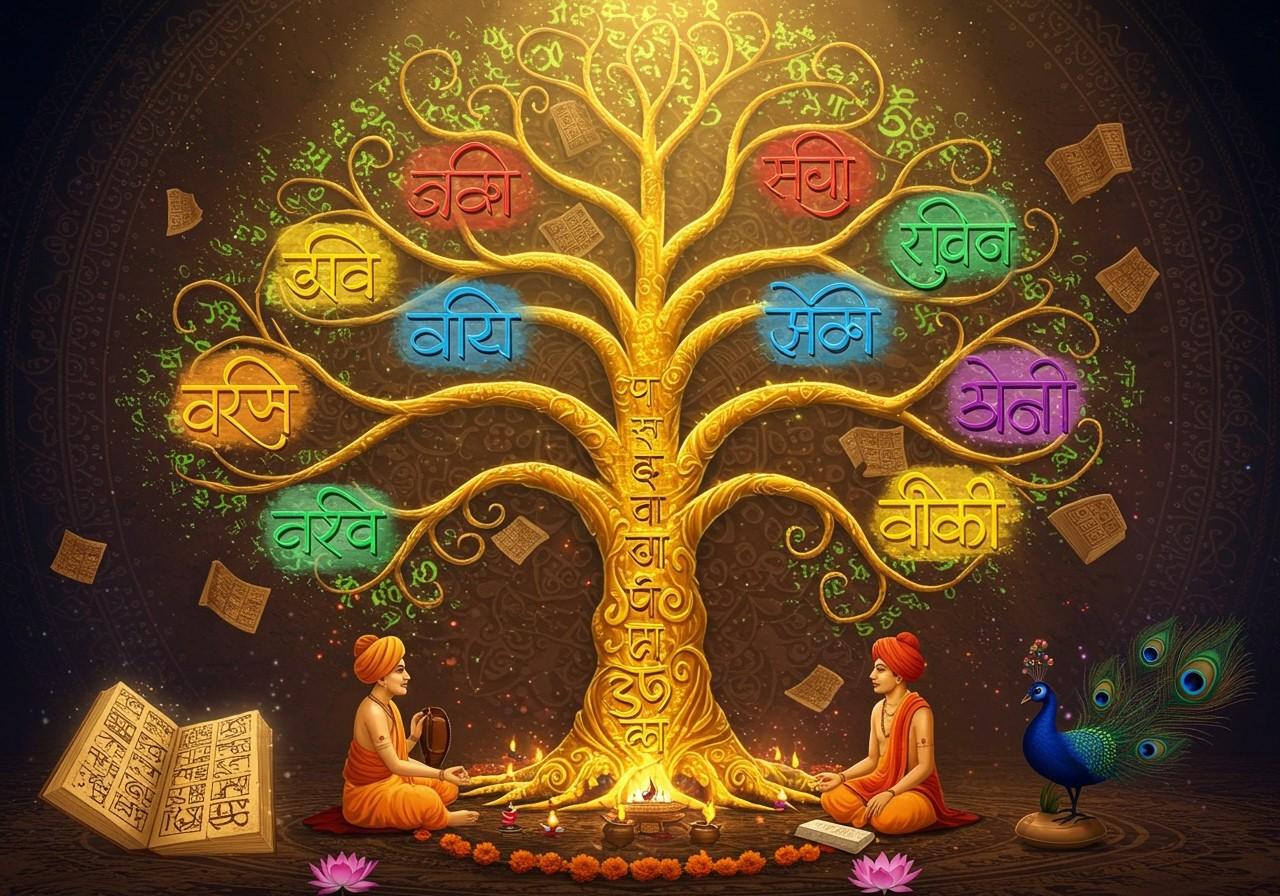
Sanskrit, an ancient language foundational to the Vedas and Hindu scriptures, has profoundly influenced Indian languages and culture. Its impact is evident in modern Indian languages like Hindi, Bengali, Tamil, Kannada, and Gujarati, which incorporate many Sanskrit words, particularly in formal and religious contexts. The National Education Policy 2020 in India emphasizes Sanskrit education to reconnect with cultural roots and understand historical and spiritual legacies.
Sanskrit’s influence extends geographically to South Asia, Southeast Asia, Tibet, China, Korea, and Japan. It shares similarities with Greek and Latin in phonetics, grammar, and script.
Sanskrit’s Impact on Hindi
Hindi, one of India’s most spoken languages, is deeply rooted in Sanskrit. Many common Hindi words, like “Aatma” (soul), “Dharma” (duty), and “Mantra” (chant), originate from Sanskrit. Hindi grammar also shares similarities with Sanskrit, particularly in the use of cases (vibhakti) and verb conjugations. Sanskrit’s influence is evident in Hindi literature, from ancient texts to contemporary works. The pronunciation of certain vowels and consonants in Hindi retains a distinct Sanskrit flavor.
Sanskrit’s Influence on Marathi
Marathi, predominantly spoken in Maharashtra, also has a significant Sanskrit influence. Words like “Shikshan” (education), “Vyakti” (person), and “Samaj” (society) are derived from Sanskrit. Marathi grammar and syntax also bear Sanskrit’s mark. The works of Marathi saints, such as Dnyaneshwar, often incorporate Sanskrit terms. The phonetic similarities between the two languages make it easier for Marathi speakers to learn and recite Sanskrit chants and shlokas, which are integral to many cultural and religious practices.
Sanskrit’s Influence on English
While not an Indian language, English has absorbed several Sanskrit words through cultural exchange. Terms like “guru,” “karma,” and “yoga” are now commonly used in English. These words frequently appear in academic and philosophical texts exploring Indian spirituality and philosophy. A deeper understanding of Sanskrit provides greater insight into these concepts.
Cultural and Linguistic Significance of Sanskrit
Sanskrit isn’t merely a language; it’s a repository of India’s cultural heritage, preserving ancient knowledge and traditions. Regional Indian languages, through their connection with Sanskrit, maintain a link to this rich past. Sanskrit chants and prayers are integral to rituals across India, connecting people to their roots. Educational initiatives promoting Sanskrit learning aim to revive this ancient language and facilitate a deeper understanding of historical texts and scriptures.
Poojn.in: Your Resource for Sanskrit and Regional Language Materials
Poojn.in understands the importance of connecting with our linguistic heritage. We are India’s leading online store for cultural and religious goods, offering a wide range of products and resources in Sanskrit and various regional languages. Explore our collection to enhance your spiritual practice and understanding of Indian culture.
- Sanskrit and Multilingual Products: Find a variety of puja items, books, and other resources in Sanskrit and other Indian languages. We strive to make authentic religious materials accessible to everyone, regardless of their linguistic background. Our offerings include Sanskrit prayer books, regional language bhajan compilations, multilingual puja guides, and more. Explore our collection today.
- Connecting You with Experts: Have questions about Sanskrit or regional language resources? Our language experts are available to assist you. Contact us at 91 7908548235 for personalized guidance on finding the perfect materials for your needs. We are dedicated to supporting your spiritual journey and helping you connect with your cultural heritage.
- Supporting Sanskrit Learning: Poojn.in believes in the importance of preserving and promoting Sanskrit. We offer resources to support Sanskrit learning, from beginner-friendly guides to advanced texts. Explore our Sanskrit mantra guide to deepen your understanding of this sacred language.
FAQs: Exploring Sanskrit and Regional Language Connections
How does Sanskrit relate to Hindi? Sanskrit is a significant ancestor of Hindi, contributing a large portion of its vocabulary and influencing its grammatical structure. Hindi evolved from Sanskrit through intermediate languages like Prakrit and Apabhramsha.
Can Sanskrit be directly translated into English? Direct translation can be difficult due to cultural and contextual nuances. While many Sanskrit words have English equivalents, capturing the full depth of meaning often requires more than a simple word-for-word substitution.
What is Sanskrit’s influence on Marathi? Marathi, like Hindi, has borrowed heavily from Sanskrit in terms of vocabulary and grammar. This makes it relatively easier for Marathi speakers to grasp Sanskrit texts and understand their cultural significance.
Why learn Sanskrit? Studying Sanskrit opens doors to understanding ancient Indian scriptures, improves comprehension of many regional Indian languages, and is believed to enhance cognitive skills due to its intricate structure. Explore the impact of Sanskrit on Indian literature.
Are there similarities between Sanskrit and other regional languages? Yes, many regional languages such as Bengali, Gujarati, Tamil, Kannada and others share Sanskrit-derived words and grammatical structures, demonstrating the widespread linguistic influence of Sanskrit across India. Explore the sacred sites of South India.
Can I learn Sanskrit online? Absolutely! Numerous online platforms offer Sanskrit courses for various levels, from beginner to advanced. These courses often include self-study materials and practice exercises.
How does Sanskrit continue to influence modern Indian languages? Sanskrit’s presence persists in modern Indian languages through vocabulary, idioms, and expressions. It also plays a role in formal and literary contexts, enriching the linguistic landscape.
Conclusion
The profound influence of Sanskrit on Hindi, Marathi, and even English underscores its enduring legacy. Recognizing these connections allows us to appreciate India’s rich linguistic tapestry and the crucial role Sanskrit has played in shaping it. By valuing and preserving Sanskrit, we honor our traditions and ensure a vibrant cultural continuity for generations to come.


